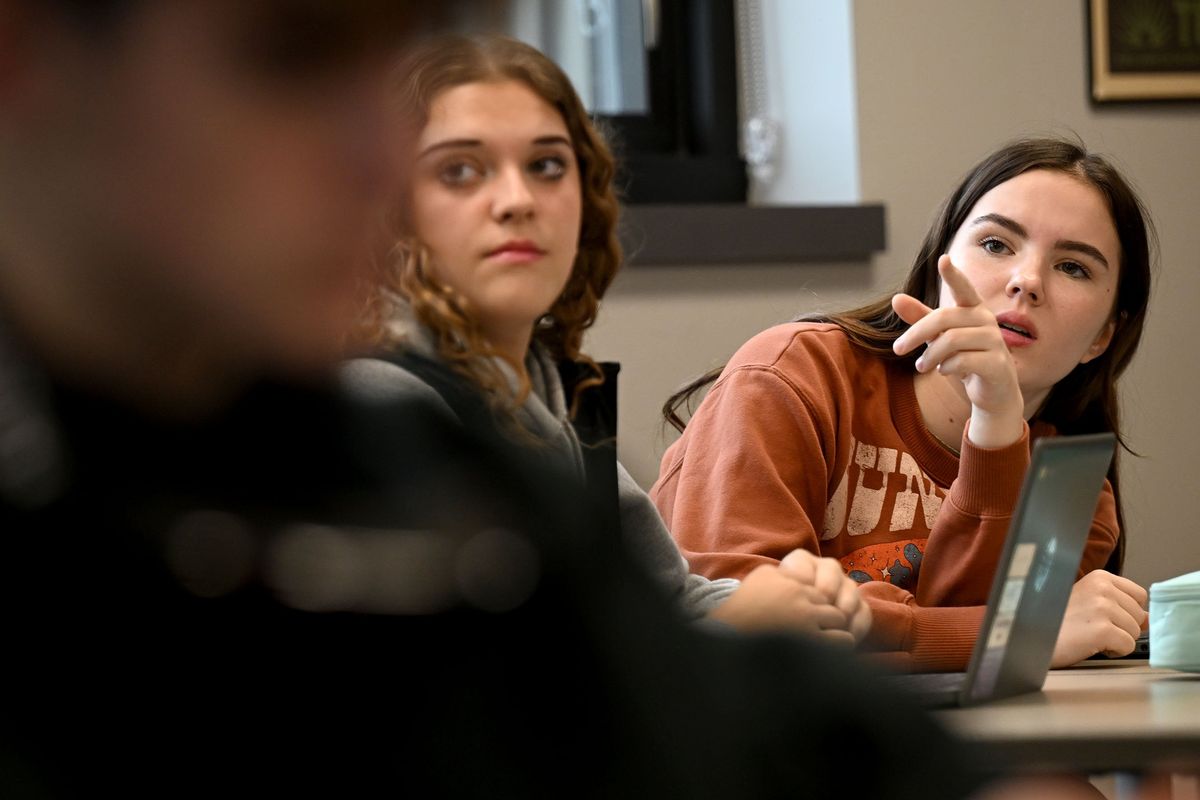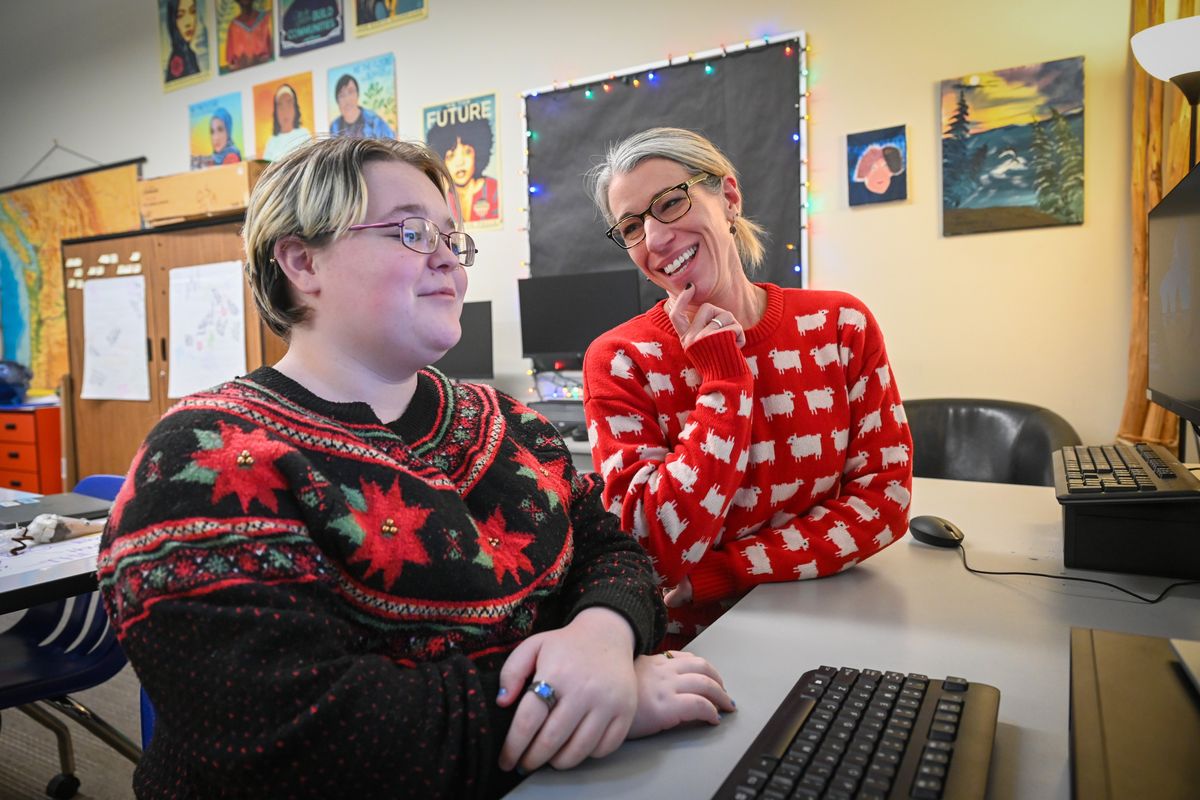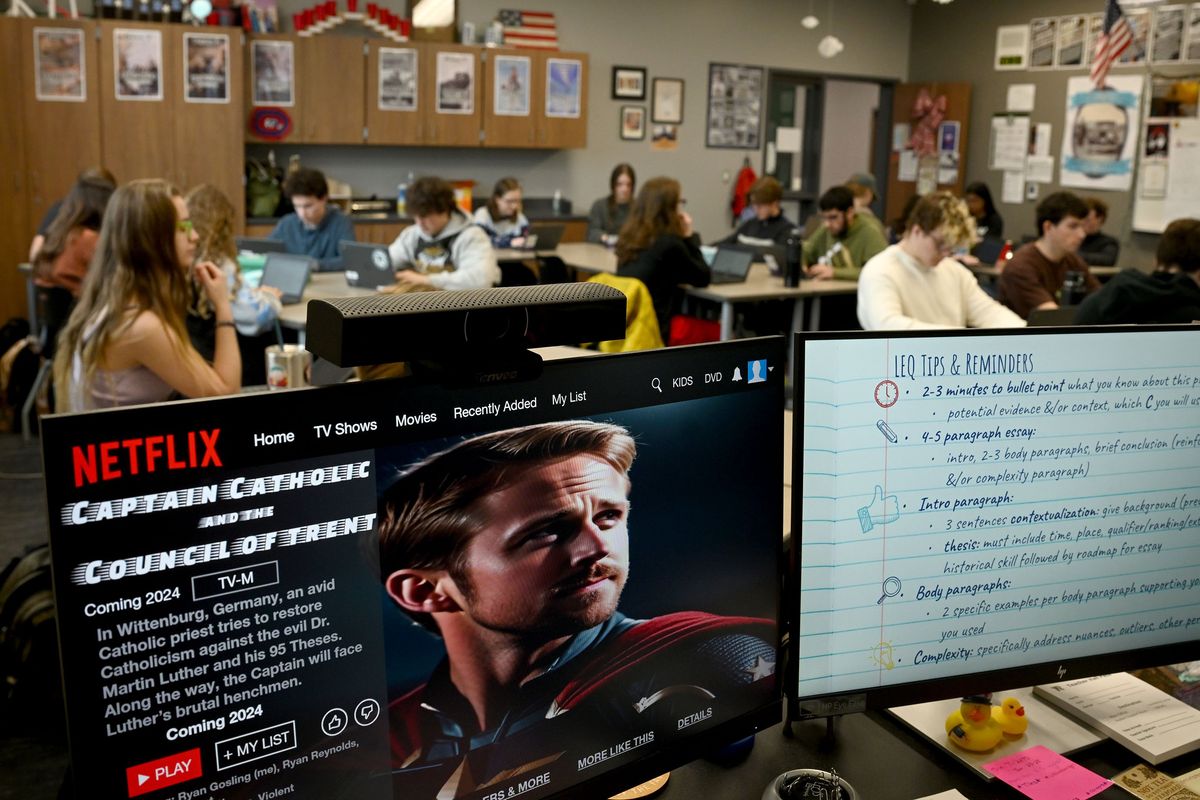‘Exponential change brought to life’: How educators are using artificial intelligence to teach
This AI-generated photograph of Ryan Gosling is part of a student project in Kathryn Teske’s class at Ridgeline High School in Liberty Lake. (KATHY PLONKA/THE SPOKESMAN-REVIEW)
Seemingly overnight, artificial intelligence, or AI, was everywhere.
“Deep down, perhaps this is the industrial revolution for knowledge workers,” said Steve Schreiner, technology and learning coordinator at the state’s Educational Service District 101, which serves county schools.
AI catapulted from science fiction to populating news headlines. It’s on the minds of humans worried it’s coming for their jobs. It’s embedded in Microsoft apps, and now AI has infiltrated the walls of K-12 Schools around Spokane.
“It is such a different way of producing things,” Schreiner explained. “If the Industrial Revolution was about physical products, now we’re talking about tools that help us mass-produce or hone knowledge products: written word, imagery, communications, things that people do significant training on can often be outsourced to AI.”
“What has happened in the last 10 months feels like it has outpaced what happened in the 10 years that preceded that,” Schreiner said. “I mean, this is exponential change brought to life.”
Schreiner likened the influence of AI on education to that of the calculator.
“You have to imagine math teachers’ feelings of horror, when suddenly the machine could do the calculations,” Schreiner said. “Of course, what it meant for math was that students’ ability to think became more valuable than their ability to compute.”
But modern teachers aren’t recoiling in terror at the advent of AI. Many are embracing the technology, viewing it as a means to stimulate student learning and a much -needed time saver.
‘Curiosity now is the limit of their learning’
The use of AI in education propels students to assess the process of learning rather than the product of learning. When students are assigned a class project to create a poster or a video, it’s about all they learn while doing the project rather than looking at the outcome itself. The same applies to inputting prompts into an AI chatbot – analyze the prompt, what the student creates, rather than the output itself. A student will need to know what to ask before they get the answer from an AI tool.
Leslie Heffernan teaches 10th- and 11th -grade English and social studies and yearbook at Mica Peak, an alternative high school in the Central Valley School District. She’s been using AI to teach in her classroom for about two months to supplement her students’ projects, such as instructing students to use proplexity.ai to generate a theme song accompanying students’ original Netflix TV show pitches on a revolution in the Atlantic.
“What I really want to teach them is that AI is a tool for enhancing your learning and enhancing what you know and are already able to do,” Heffernan said. “How can we use it just to level up our thinking?”
Kathryn Teske, who teaches AP U.S. and European History at Ridgeline High School in the Central Valley district, led a similar Netflix-inspired lesson plan for her 10th- to 12th -graders. The creative project helps the content stick for her students rather than simply reading text book entries about various transatlantic revolutions.
“You guys have to know the content, but you don’t have to know how to write a theme song – that’s not an essential part of my course,” Teske said she tells her students. “Might it help you to remember something? Absolutely.”
Their finished projects could easily sneak in among the other titles on streaming services’ home screens and be mistaken for a Netflix original. Students came up with their show’s title, casting and four episode plot lines that accurately reflect the events of their chosen revolution. To make their projects more dynamic, students used AI to generate a title card for their show and four stills to accompany their directed episodes, and another system to create a theme song. Students had to scrutinize their AI songs and edit information for accuracy, testing their knowledge on the subject and practicing their critical thinking about AI-generated information.
Ridgeline juniors Dallas Adamson and Ryland Jacoby, who imagined a retelling of the protestant reformation, Luther, said it helped them remember the causes and effects of the period.
“The song was catchy, it helped me retain the information,” Jacoby said.
Retention is critical in AP classes, where a national test looms in May wherein students are expected to recall five centuries of European history. Teachers have long been leading students in creative endeavors to get information to stick: making posters, designing board games, scripting plays. The value has never been in the creation of these projects, Teske said, they’ve always been a tool to stimulate retention and interaction with the content. Now, they’re using the new tool of AI at their disposal to do the imagining for them.
“It’s definitely a fun and exciting way to learn; I kind of liked tying AI-generated images to the projects,” Adamson said.
Loreley Smith, library information specialist at North Central High School, said teachers have instructed students to use AI tools to guide them in creating an outline for their writing. While there is educational benefit to a student organizing and planning their writing themselves, an AI chatbot can hold students’ hands in this process, helping them to get an essay started. Ideally, Smith said, the AI is a scaffold for students. After a few projects started with AI, students will become more comfortable doing the work themselves and take over from there.
Smith noted a science teacher using AI to reduce the Lexile level in scientific journals written in technical jargon, making complicated genomics research accessible to teenagers, some of whom use English as a second language.
AI presents creative avenues for learning for elementary students as well; Joseph Arnhold, library information specialist at Longfellow Elementary, is excited by an AI tutor called Khanmigo. Students can ask the software questions they’d ask their teacher, like how to spell “know” or ponder why the sky is blue.
“You could delve into an endless pit of learning,” Arnhold said. “But it’s there to give you that answer.
“A kid’s curiosity now is the limit of their learning.”
The software also allows students to “interview” historical figures. Rather than read or watch a video about Sir Isaac Newton’s discovery of gravity, kids can ask questions to an artificial version of the physicist, a more engaging style of learning, Arnhold said.
Behind the curtain
If you asked a teacher what they’re lacking, they’d likely say time.
“Teachers are always asking for more time,” Arnhold said. “If you can give a teacher more time, then they can be more effective.”
In juggling the needs of dozens of kids at an elementary level and more than 100 in high school, it’s easy for teachers of any grade to get overwhelmed.
“It’s not a 40-hour job,” said Smith, a former English teacher. “Teachers spend hours outside of their class time preparing lessons, coming up with new, fresh ideas to keep students engaged and interested and keep things relevant. Creating rubrics can be tedious, and it doesn’t need to be.”
In pulling back the teacher’s curtain, educators can use AI-powered tools to shave time doing some of the many tasks that eat away at a teacher’s school day: grading papers, designing rubrics, inventing engaging math story problems and writing student examples in the voice of a student.
Heffernan uses AI chatbots like another person to bounce her ideas off of. She’ll approach it with a question, and then refine what she wants until the answer suits the desired result. That process might include, for example, asking for a collaborative element in a classroom activity or more specific requirements in a rubric.
Without collaborators to brainstorm, AI can help.
“It’s really become more like a teaching assistant than I thought it would be,” Heffernan said. “It’s actually helping me to be more creative, too. I mean, I can ask it for anything.”
In practicing what she preaches to her pupils, an AI-generated rubric or lesson plan usually needs a fair amount of tweaking, but it’s easier to work with an imperfect draft than a daunting blank sheet of paper.
At an AI training for Central Valley teachers, educational consultant Jeff Utecht estimated using AI can save teachers three to five hours a week by doing tasks like writing lesson plans, rubrics, math word problems, practice questions and readings and example answers.
“Folks, work you have to do anyway,” Jeff said while gesturing to the screen as ChatGPT generates a rubric on a third -grade unit surrounding forts on the Oregon Trail.
“My heart is racing thinking of how much time this is going to save me,” one teacher in attendance said.
The software, not having any degrees in education nor years of experience in the field like the teachers who use it, doesn’t create perfect rubrics or lesson plans. That’s where teachers use their expertise to correct errors or refine language. Utecht estimates teachers will have to alter around 25% of what AI generates.
“It’s an OK lesson,” Utecht said of plans he generated during the training. “But remember, I had no lesson 10 seconds ago, and now I have a lesson.”
Responding to student feedback is another task that eats away at a teacher’s day, especially for Teske at Ridgeline, who often assigns long and short essay questions for students in preparation for the AP test.
Teske said the longer-than-optimal turnaround time for getting students their feedback before they forgot what they submitted is one of her largest areas of “teacher guilt.”
Students respond to the prompt directly on the software, and when they’re finished writing, get feedback within a moment of clicking “submit.” In some systems Teske has piloted with her students, they’re allowed to resubmit after applying the AI’s feedback.
“It’s not perfect, but as a teacher it takes so long to give good feedback on writing. I have so many students,” Teske said. “I’m still going to read everything they write, but this feedback is instant.”
Students’ opinions on the software varied. Some said the critiques were “nitpicky” or asked for information they’d felt they already covered. Others appreciated the specificity of the advice and were able to apply the feedback and improve their writing.
“I understand where I went wrong and I know what I can do better,” said senior Zander Palm.
“It gave me really specific feedback right away,” said junior Kyla Ross. “While it’s still, like, fresh in your brain.”
Junior Jaycee Lawhead agreed the instantaneous assessment was helpful and recognized the time it saves Teske, but students said they preferred that of their teacher to the machine.
“It can’t understand what we’re thinking like she can,” Ross said. “It’s almost like a sympathy thing.”
Some, like senior Zachariah Taylor, said the machine was unhelpful in that it advised him to write about something he did.
“I feel I would have gotten these points. I’ve written these essays many times,” said junior Alex House. “That’s so odd.”
The software isn’t without its hiccups. After submitting nearly an hour’s worth of content, some students’ work was completely erased. To them, Teske promised conciliatory cookies.
Another fault in the technology isn’t just present in its educational uses. AI chatbots compile responses based on information gathered from the internet to craft responses. All the racism, sexism, homophobia and other biases of the internet have left their impression on AI tools that influence their responses to prompts. In a chatGPT-generated list of books written by women about scientific discovery, two of 10 books were written by men, though with forewords written by women. When asked for a fifth-grade math story problem designed to engage Black youth, ChatGPT produced a question about Jamal playing basketball.
The algorithm is like a toddler, Utecht said, in that if it doesn’t know the answer to a query, it’ll make something up, called “hallucinating.” ChatGPT, for instance, is only programmed with information pre-2022.
Some education-specific software are more scrupulous about the information presented and the sources from where they gather data. Some list the sources of their information, which educators said is a helpful starting point in pupils’ research endeavors. In evaluating any output, critical thinking from the user is key.
With less of their time theoretically bogged down with menial tasks, teachers can spend more interpersonal time with students, plan fun excursions and outings, and innovate how they teach.
“Kids need so much more of your energy and your time making connections with social, emotional and behavioral issues,” Smith said. “If you have some assistance on the things that can be done smoothly and quickly through AI, you can spend more time building the relationship with the students.”
While also spurring excitement over the prospects of the new tool in enhancing learning and making teachers’ jobs easier, they’re also wary of how the mere existence of the technology is altering the world in which educators are preparing youth to enter. With the proliferation of AI, educators said a shift in teaching students how to think rather than what to think is necessary.
While the advent of AI can take much off teachers’ plates, the same can be said for those who generate malicious misinformation and scams to capture clicks online, Arnhold said. They can now use AI to do their worst, faster. Now more than ever, educators said, students will need instilled in them the importance of critical thinking and healthy skepticism.
“I think we have to develop in our kids a curiosity to explore more and also the ability to be highly critical and doubt what’s being shared,” Schreiner said. “I mean, I don’t want to say that kids need to be prepared to be scammed all the time, but it’s almost that there is the potential that these tools sound so audibly correct, to me (it sounds) like an authoritative voice, that I have to bring my skepticism to any interaction with these tools.”
Developing a student’s scrutiny starts young.
Arnhold shares with Longfellow first-graders the ecological wonder that is the Pacific Northwest tree octopus. Residing in the old-growth forests of the Olympic Peninsula, it’s one of the most elusive creatures known to man, claims a website dedicated to the endangered species. At first, kids believe there could be such a thing as an arboreal octopus. After all, it has a whole website with blurry photos and seemingly authentic testimony of sightings. Often, a couple kids are doubtful of the cephalapod’s existence. It’s then that Arnhold reveals the farce: It’s an intentionally misleading website designed to teach wariness among internet users.
Kids are often exposed to false information like the tree octopus, especially with the ease of access to the internet and all the woes therein. While it may seem futuristic or dystopian, AI is a reality kids need to be prepared for, educators said.
“You’re watching Star Wars, and they have a little robot that flies with them. Well, we have drones today,” Arnhold said. “We have computers in our pockets, and our third-graders have computers in their pockets, so they’re going to have a companion with them, and they’re too young to understand fake or real or whatever it is. It’s almost more important to really have that foundation in elementary today to help prepare them for this future.”


